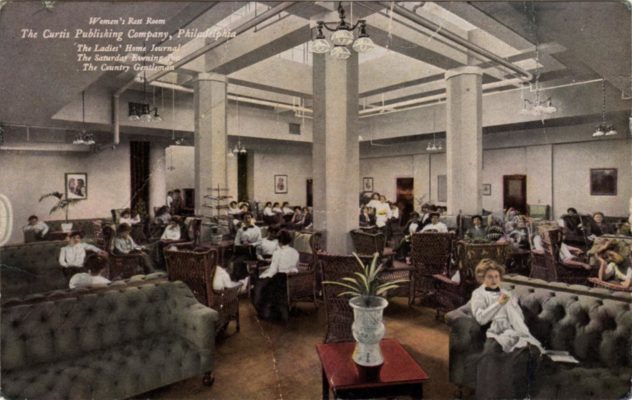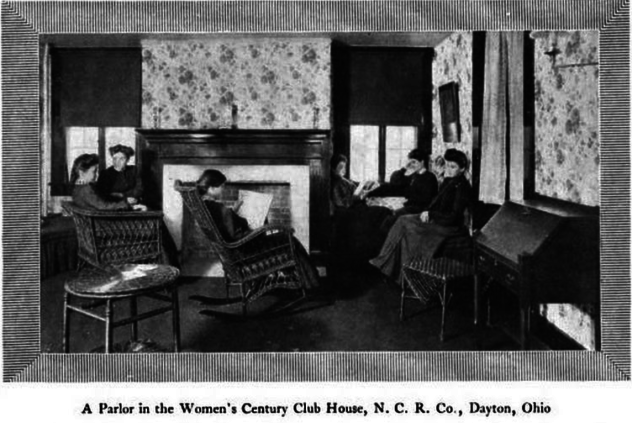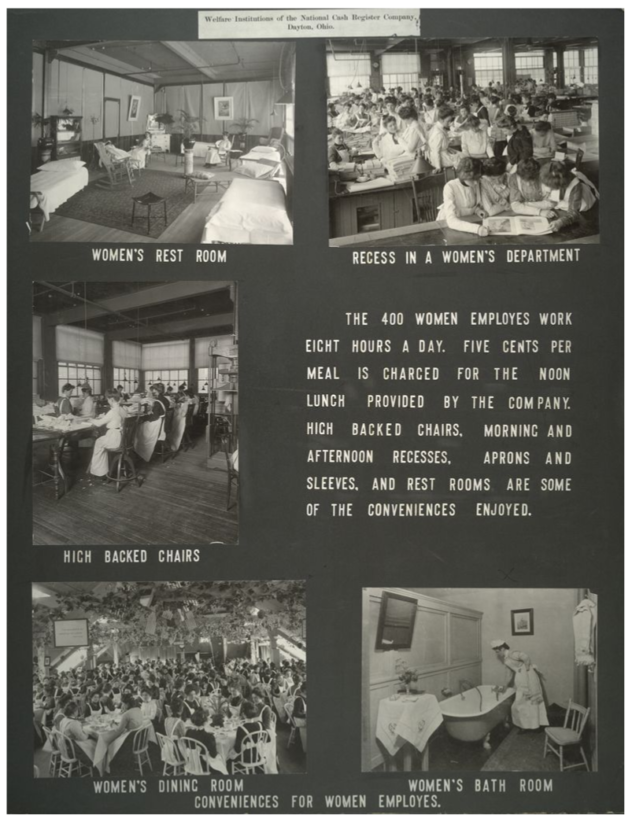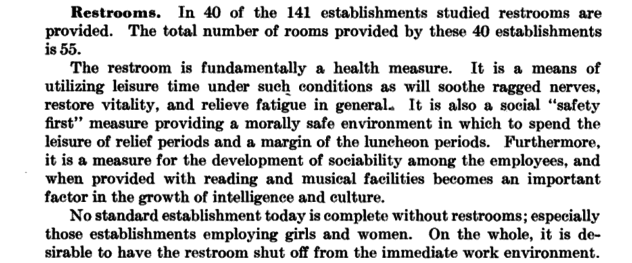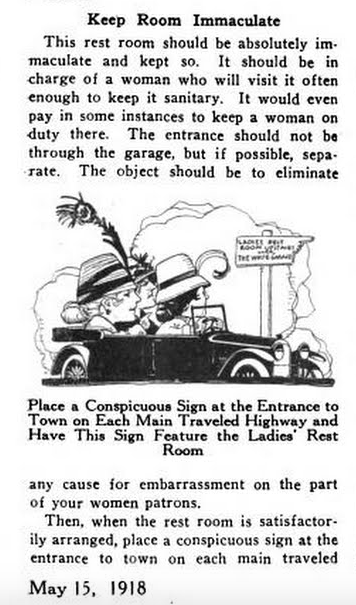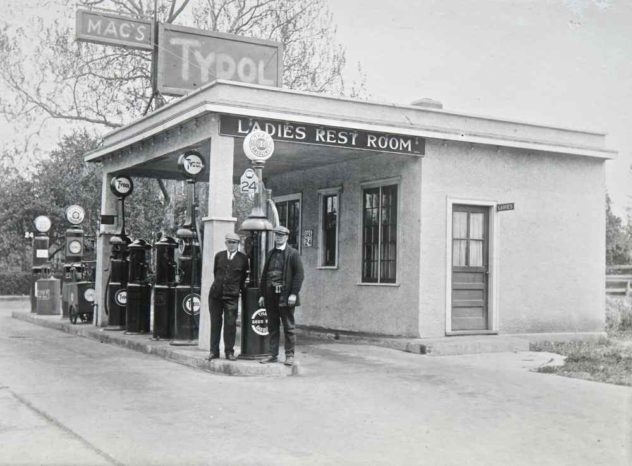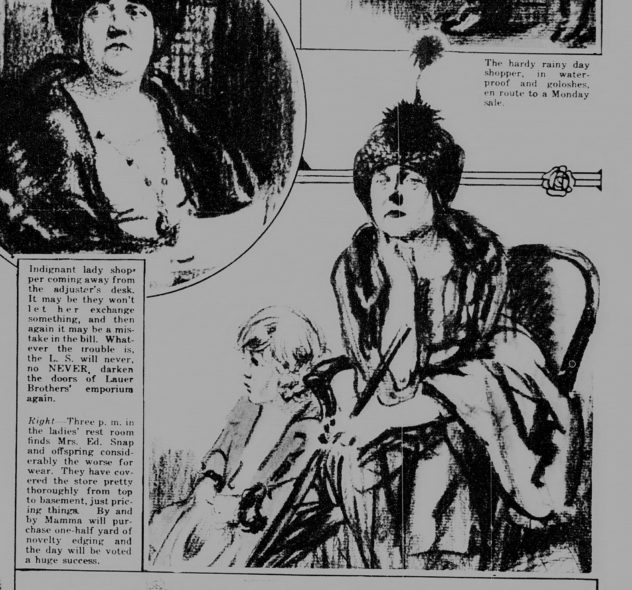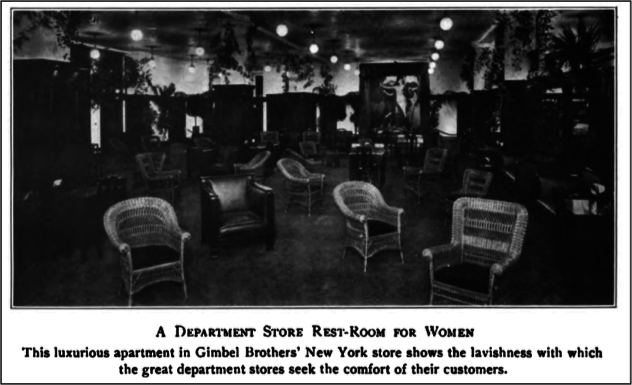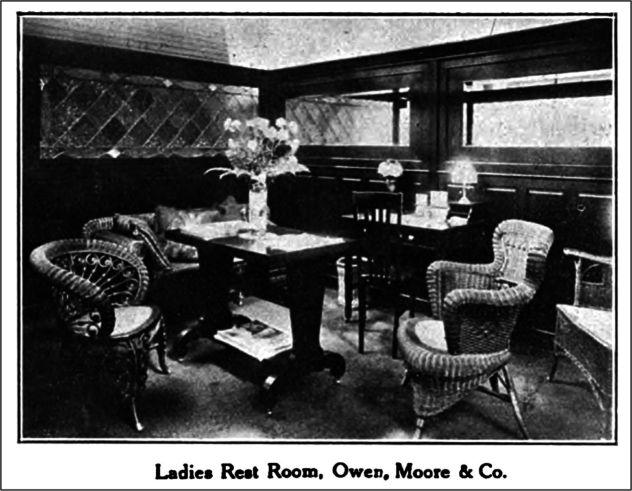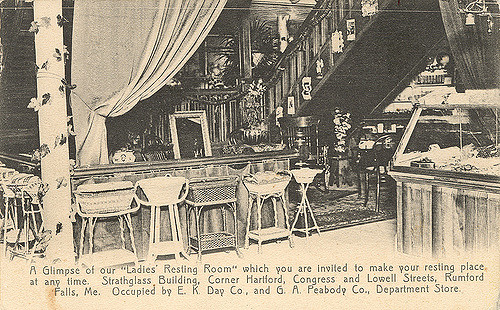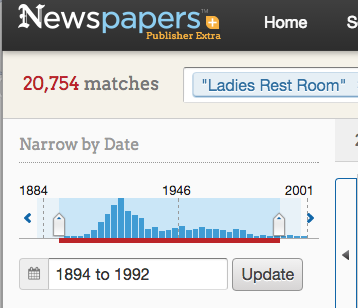Many women observed International Women’s Day yesterday by going on strike to demonstrate what daily life would be without women. This made people reflect on the role of women in today’s society, but it also reminded me that the absence of women in the public spaces was something that was commonplace in the not-so-distant past. I am familiar with these issues because of the research that I did for my master’s thesis on ladies’ rest rooms.
And no, it’s not what you are thinking, the term ladies’ rest rooms originally had nothing to do with public bathrooms, but rather they were literally rooms that were created to provide women with a place to rest.
A Postcard Depicting the Ladies’ Rest Room at the Curtis Publishing Offices
At the turn of the twentieth century, advertisements and descriptions of these rooms suddenly appear in newspapers and trade publications. This emergence coincides perfectly with a time when the public lives of women were rapidly changing. During the Victorian Era, there was a prevailing idea that women (or at least white, reasonably wealthy women) belong at home in the sphere of domesticity. Men, on the other hand, were the ones who were expected to go out in public to be seen and conduct business. This article, “Rustics’ Rest Room,” published in a 1921 edition of Home Lands illustrates the struggles rural women faced when they went into town with their husbands:
Excerpt from “Rustics’ Rest Room”
Perhaps the most telling line is: “Her errands done, the country shopper has nothing to do and nowhere to go while possibly waiting for her men or the interurban to take her home, but to walk the streets or stand on some corner ready in her own words, “to drop with fatigue.”
But the daily lives of women were changing in the early twentieth century. For example, they were increasingly employed outside of the home in industrial jobs; this industrialization leads to a drop in the price of commodity goods and an increase in items being purchased for the household rather than made at home. There was also the introduction of the automobile, which made it easier than before for women to travel farther away from home, and by 1920, women were finally given the right to vote. Interestingly, the use and proliferation of ladies’ rest rooms paralleled these changes that resulted in more women entering previously male-dominated spaces. Below are several articles highlighting some of these examples:
Women in the Workplace
The above picture is from a 1905 volume of the trade publication Social Service: A Monthly Review of Social and Industrial Betterment. The article states “An ample rest room is provided for use during the noon hour or at other times during the day when a girl may need it. They are encouraged to make use of this room and may have any needed medical assistance.”
The Harvard Art Museum’s Social Museum Collection has more images of the women’s facilities at N.C.R in Dayton, Ohio.
This article in the Bulletin of the Extension Division, Indiana University, 1917 describes the rest room as a fundamental “health measure” and even suggests having one for men as well (but especially women).
Rest Rooms for Automobile Travelers
This next example is one of my favorite articles I found describing a Ladies’ Rest Room. It is titled “Three Methods for Increasing Garage Business” and it was published in Horseless Age: The Automobile Trade Magazine in 1918. The author describes at length the financial benefit of including a Ladies Rest Room at your auto repair shop. Here is an excerpt:
What’s amusing about this example is that the writer, a man, explicitly states that women should avoid the male space of the garage to spare them the embarrassment?!
Either way, it looks like Mac’s Tydol filling station took most of the advice in this article in setting up his ladies’ rest room, you can even see the separate entrance in this photo:
Image from The Old Motor website
It’s also fascinating to see how this example is tied to a public bathroom and it provides a hint of how the term “restroom” became synonymous with public bathrooms today. This article also alludes to how later examples of ladies’ rest rooms were used to market to women and sell them more products.
Ladies Rest Rooms in Department Stores
Today, when I tell people about these types of rooms, the thing most women can relate to is the experience of going into a large department store and seeing a small lounge attached to the bathroom facilities. This is a direct remnant of the ladies’ rest rooms of the early twentieth century. Here are some examples of rest rooms established in department stores:
This illustration from the New York Tribune on 19 February 1922 shows “Mrs. Ed Snap and offspring” who were “considerably worse the wear” resting in the ladies’ rest room after a busy day of shopping at the department store.
I also found the most pictures of ladies’ rest rooms in advertisements for department stores, since they were used as tools to market towards women to entice them to buy goods where they felt more “at home.” Here are a few of my favorites:
Ladies’ rest room in the Owen, Moore & Co. Store in Portland, Maine. (Board of Trade Journal, November 1909, Vol. 22 No. 7)
Image depicting a ladies’ rest room in the Gimbel Brothers’ Department Store in New York. (From What Eight Million Women Want by Rheta Childe Dorr, Small, Maynard & Co. 1910.)
Image from the Rumford, Maine Historical Society
Ladies Rest Rooms as Transitional Public Spaces
The above examples are only a small subsection of the places one could find a ladies rest room. They were featured in many other public places such as schools, universities, libraries, civic and community buildings, county and state fairs, movie theaters, hotels, public comfort stations, and nearly all public spaces that a woman would encounter in her daily life in the early twentieth century.
What’s most revealing from all the research I have done on these rooms, is how quickly they disappear after women gain more rights and free access to all spaces. This is perfectly illustrated by typing in the search term “Ladies Rest Room” into Newspapers.com:
You can see by the number of results returned for each year the quick emergence starting around 1905 and then a peak in 1919. By the 1930s, the advertisement and use of these rooms rose sharply. Shortly after that, the term also takes on a new meaning as a euphemism for a public bathroom as it is used today.
I know from the descriptions and images, it doesn’t seem like these rooms were liberating spaces for women, but that’s mostly because they were later co-opted and used as marketing tools to draw women to particular public places. It’s significant to note that the earliest examples were created for rural women by local women’s clubs. It was the actions of women who started carve out little transitional spaces for themselves in predominately male places. Over time the use of rest rooms grew as women entered in more public spaces in their daily lives.

A newspaper article describing how a women’s club is establishing a Ladies’ Rest Room in Kansas. The Osage City Free Press 30 April 1903
Another thing that is striking to me is how funny and strange some of the quotes about women’s “constitution” may seem today, but these descriptions weren’t written that long ago. My own grandmother was born in 1924 when these rooms were still in abundant use. It’s a reminder of how far we have come thanks to movements that were sparked by women for women and I hope this trend continues for future generations.
Note: If you’d like to learn more about ladies’ rest rooms, you can read my full thesis here.


